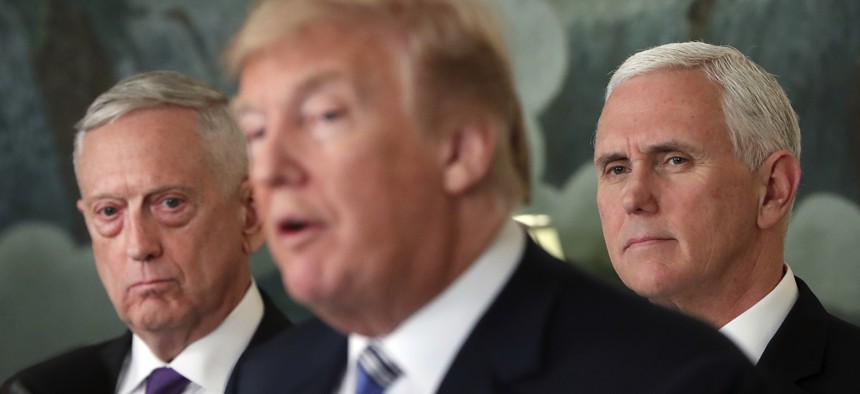
Defense Secretary Jim Mattis, left, and Vice President Mike Pence, right, listen to President Donald Trump, center, in the White House in Washington, March 23, 2018. AP / Pablo Martinez Monsivais
New Transgender Policy Is Grounded in Common Sense
It allows qualified individuals to serve, and excludes only those for whom the stresses of military life present unacceptable risk.
The Pentagon’s new transgender policy, announced Friday, is based on fact, versus political correctness. It allows transgender individuals who are not experiencing the mental anxiety or anguish of gender dysphoria to serve their country. At the same time, it correctly returns gender dysphoria—which impedes military readiness—to a disqualifying service criterion.
The policy, suggested by Defense Secretary James Mattis and approved by President Trump, rightly draws a distinction between transgender and gender dysphoria. The former term describes individuals whose gender identity differs from their biological sex. The latter applies to the subset of transgender individuals who experience discomfort with their biological sex. This distinction is a critical factor informing the new policy, as individuals suffering from gender dysphoria often experience “significant distress or difficulty functioning.”
Under the policy, transgender persons (with some exceptions) with a history of gender dysphoria are disqualified from military service. Transgender individuals who have undergone a gender transition also are disqualified. This is wise and evidence-based.
The discomfort and distress of individuals suffering from gender dysphoria is well understood. Self-reported survey data and military medical treatment data from transgender individuals confirm that they experience severe anxiety and attempt suicide at eight to 10 times the rate of the general U.S. adult population. At a time when the U.S. military is already suffering from increased rates of suicide, it would be irresponsible to introduce a population into military ranks demonstrably at greater risk of mental anxiety.
The policy is in line with long-established Defense Department policy to deny entry to those who might be more likely to become a casualty from military service. That policy exists both to protect the individuals’ safety and to preserve the lethality of the force. It is no different from existing military entrance criteria which treat mental depression, past suicide attempts, exercise-induced asthma or severe anxiety as disqualifying.
The revised policy allows transgender individuals not experiencing gender dysphoria to remain in the military, with the provision that they serve in their biological sex. This is appropriate given that many standards in the military—including those pertaining to physical fitness and body fat, as well as berthing, bathroom and drug testing procedures—are directly linked to biological sex.
Due to U.S. demographics, growing obesity and other factors, the military today and in the coming years will be increasingly hard-pressed to fill its ranks. It therefore makes sense to retain those who have served honorably and who have demonstrated the ability to perform satisfactorily, as long as they continue to meet commonly applied deployment criteria.
In announcing the policy, Secretary Mattis wrote that research that provided the rationale for President Obama’s policy regarding transgender service members had “serious shortcomings.” To explore this issue, six months ago the secretary formed a panel of experts consisting of senior uniformed and civilian defense leaders. The panel met with a wide range of medical experts, transgender individuals, and commanders.
The panel found that the research used by the previous administration “referred to limited and heavily caveated data to support its conclusions, glossed over the impacts of healthcare costs, readiness and unit cohesion, and erroneously relied on the selective experiences of foreign militaries with different operational requirements than our own.” In short, the very foundation upon which the previous administration based its change to existing Defense Department policy was deeply flawed.
Critics may argue that the military was in the forefront behind lifting restrictions on the service of blacks, women and gay individuals, and that transgender should be treated similarly. The comparison is wholly invalid—ample data confirm that transgender persons with gender dysphoria experience significant adverse medical—not social—disqualifying issues for military service.
Last week’s announcement by the president and Secretary Mattis strikes the proper balance by allowing qualified individuals to serve, while keeping out of service those individuals for whom the stresses of military life present unacceptable risk—both to their own safety and to the readiness of their unit.
Some had criticized the administration for taking so long to examine the implications of this issue. But by taking the time to review the research and consult with a wide range of experts both within and outside of the military, the administration has crafted a fair and rational policy.

